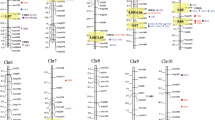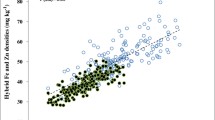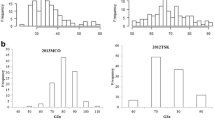Abstract
Phytate (inositol-hexa-phosphate) has an important role in plants but it also may have anti-nutritional properties in animals and humans. While there is debate within the plant breeding and nutrition communities regarding an optimum level in grain, there appears to be little information at the molecular level for the genetics of this trait, and its association with important trace elements, in particular, Fe and Zn. In this preliminary study, quantitative trait loci (QTL) for grain phytates, Zn and Fe in glasshouse-grown rice lines from an IR64 × Azucena doubled haploid population were identified. Correlations between phytate and essential nutrients were also studied. Transgressive segregation was found for most traits. Phytate and total P concentrations had one QTL in common located on chromosome five with the (high concentration) allele contributed from Azucena. There were significant positive correlations between phytate and inorganic phosphorus (P), total P, Fe, Zn, Cu and Mn concentrations for both grain concentration and content. However, the QTLs of phytate were not located on the same chromosomal regions as those found for Fe, Zn and Mn, suggesting that they were genetically different and thus using molecular markers in breeding and selection would modify the phytate level without affecting grain micronutrient density.
Similar content being viewed by others
References
Bentsink L, Yuan K, Koornneef M, Vreugdenhil D (2003) The genetics of phytate and phosphate accumulation in seeds and leaves of Arabidopsis thaliana, using natural variation. Theor Appl Genet 106:1234–1243
Causse MA, Fulton TM, Cho YG, Ahn SN, Chunwongse J, Wu KS, Xiao JH, Yu ZH, Ronald PC, Harrington SE, Second G, McCouch SR, Tanksley SD (1994) Saturated molecular map of the rice genome based on an interspecific backcross population. Genetics 138:1251–1274
Graham RD, Welch RM, Bouis HE (2001) Addressing micronutrient malnutrition through enhancing the nutritional quality of staple foods: principles, perspectives and knowledge gaps. Adv Agron 70: 77–142
Gregorio GB, Senadhira D, Htut H, Graham RD (2000) Breeding for trace mineral density in rice. Food Nutr Bull 21:382–386
Guiderdoni E, Galinato E, Luistro J, Vergara G (1992) Anther culture of tropical japonica × indica hybrids of rice (Oryza sativa L.). Euphytica 62:219–224
Huang N, McCouch SR, Mew MT, Parco A, Guiderdoni E (1994) Development of a RFLP map from a double haploid population in rice. Rice Genet Newsl 11:134–137
Marschner H (1995) Mineral nutrition of higher plants. Academic Press, London
Panaud O, Chen X, McCouch SR (1996) Development of microsatellite markers and characterization of simple sequence length polymorphism (SSLP) in rice (Oryza sativa L.). Mol Gen Genet 252:597–607
Raboy V (2002) Progress in breeding low phytate crops. J␣Nutr 132:503–505
Raboy V (2001) Seeds for a better future: ‘low phytate’ grains help to overcome malnutrition and reduce pollution. Trends Plant Sci 6:458–462
Temnykh S, DeClerck G, Lukashova A, Lipovich L, Cartinhour S, McCouch SR (2001) Computational and experimental analysis of microsatellites in rice (Oryza sativa L.): frequency, length variation, transposon associations, and genetic marker potential. Genome Res 11:1441–1452 [http://ricelab.plbr.cornell.edu/publications/2001/temnykh/]
Temnykh S, Park WD, Ayres N, Cartinhour S, Hauck N, Lipovich L, Cho YG, Ishii T, McCouch SR (2000) Mapping and genome organization of microsatellite sequences in rice (Oryza sativa L.). Theor Appl Genet 100:697–712
Wang S, Basten CJ, Zeng ZB (2005) Windows QTL cartographer 2.5. Department of Statistics, North Carolina State University, Raleigh, NC [http://statgen.ncsu.edu/qtlcart/WQTLCart.htm]
Welch RM (2002) Breeding strategies for biofortified staple plant foods to reduce micronutrient malnutrition globally. J Nutr 132:495S–499S
Zarcinas BA, Cartwright B, Spouncer LR (1987) Nitric acid digestion and multi-element analysis of plant material by inductively coupled plasma spectrometry. Comm Soil Sci Plant Anal 18:131–146
Zeng ZB (1994) Precision mapping of quantitative trait loci. Genetics 136:1457–1468
Acknowledgements
Funding from the Asian Development Bank and HarvestPlus are gratefully acknowledged. Analytical expertise from the Waite Analytical Service, the delivery of seed from Dr. Glenn Gregorio at IRRI, online SSR markers database from Prof. Susan McCouch, assistance in QTL analysis by Dr. Paul Lonergan and Dr. Shengchu Wang, statistical advice by Dr. Trevor Hancock and valuable comments from the referees are also gratefully acknowledged.
Author information
Authors and Affiliations
Corresponding author
Rights and permissions
About this article
Cite this article
Stangoulis, J.C.R., Huynh, BL., Welch, R.M. et al. Quantitative trait loci for phytate in rice grain and their relationship with grain micronutrient content. Euphytica 154, 289–294 (2007). https://doi.org/10.1007/s10681-006-9211-7
Received:
Accepted:
Published:
Issue Date:
DOI: https://doi.org/10.1007/s10681-006-9211-7




